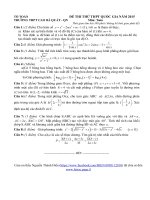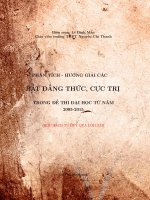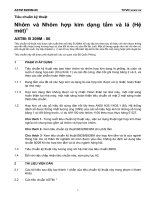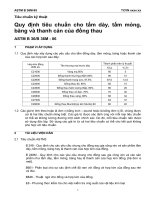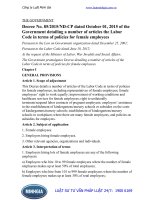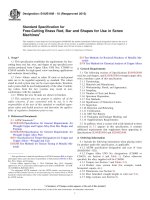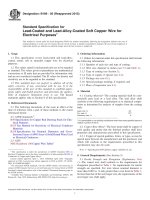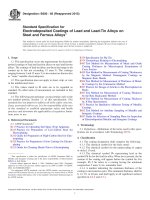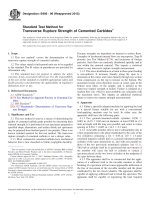Astm b 200 85 (2015)
Bạn đang xem bản rút gọn của tài liệu. Xem và tải ngay bản đầy đủ của tài liệu tại đây (111.43 KB, 6 trang )
Designation: B200 − 85 (Reapproved 2015)
Standard Specification for
Electrodeposited Coatings of Lead and Lead-Tin Alloys on
Steel and Ferrous Alloys1
This standard is issued under the fixed designation B200; the number immediately following the designation indicates the year of
original adoption or, in the case of revision, the year of last revision. A number in parentheses indicates the year of last reapproval. A
superscript epsilon (´) indicates an editorial change since the last revision or reapproval.
This standard has been approved for use by agencies of the U.S. Department of Defense.
B339 Specification for Pig Tin
B374 Terminology Relating to Electroplating
B487 Test Method for Measurement of Metal and Oxide
Coating Thickness by Microscopical Examination of
Cross Section
B499 Test Method for Measurement of Coating Thicknesses
by the Magnetic Method: Nonmagnetic Coatings on
Magnetic Basis Metals
B504 Test Method for Measurement of Thickness of Metallic Coatings by the Coulometric Method
B507 Practice for Design of Articles to Be Electroplated on
Racks
B567 Test Method for Measurement of Coating Thickness
by the Beta Backscatter Method
B568 Test Method for Measurement of Coating Thickness
by X-Ray Spectrometry
B571 Practice for Qualitative Adhesion Testing of Metallic
Coatings
B602 Test Method for Attribute Sampling of Metallic and
Inorganic Coatings
B697 Guide for Selection of Sampling Plans for Inspection
of Electrodeposited Metallic and Inorganic Coatings
1. Scope
1.1 This specification covers the requirements for electrodeposited coatings of lead and lead-tin alloys on steel and ferrous
alloys. The coatings of lead-tin alloys are those that range in tin
content up to but not exceeding 15 mass %. The coatings
ranging between 3 and 15 mass % in tin content are known also
as “terne” metallic electrodeposits.
1.2 This specification does not apply to sheet, strip, or wire
in the unfabricated form.
1.3 The values stated in SI units are to be regarded as
standard. No other units of measurement are included in this
standard.
1.4 The following precautionary caveat pertains only to the
test method portion, Section 11, of this specification: This
standard does not purport to address all of the safety concerns,
if any, associated with its use. It is the responsibility of the user
of this standard to establish appropriate safety and health
practices and determine the applicability of regulatory limitations prior to use.
2. Referenced Documents
2.1 ASTM Standards:2
B117 Practice for Operating Salt Spray (Fog) Apparatus
B183 Practice for Preparation of Low-Carbon Steel for
Electroplating
B242 Guide for Preparation of High-Carbon Steel for Electroplating
B320 Practice for Preparation of Iron Castings for Electroplating
B322 Guide for Cleaning Metals Prior to Electroplating
3. Terminology
3.1 Definitions—Definitions of the terms used in this specification are in accordance with Terminology B374.
4. Classification
4.1 The coating designation shall comprise the following:
4.1.1 The chemical symbol for the basis metal.
4.1.2 The chemical symbol for the undercoating of copper
or nickel, if used.
4.1.3 The chemical symbol Pb representing lead or the
symbol Pb Sn for the lead-tin alloy. When tin is present, the tin
content of the coating will appear before the symbol Sn. For
example, Pb 5 Sn refers to a coating having the minimum
composition 5 mass % tin, remainder lead.
4.1.4 A number indicating the minimum thickness of the
coating in micrometres (µm). This minimum thickness shall be
6, 12, 25, or 40 µm, and shall apply to all significant surfaces
specified in 8.2.2 and 8.3.1.
1
This specification is under the jurisdiction of ASTM Committee B08 on
Metallic and Inorganic Coatings and is the direct responsibility of Subcommittee
B08.06 on Soft Metals.
Current edition approved March 1, 2015. Published April 2015. Originally
approved in 1970. Last previous edition approved in 2009 as B200 – 85 (2009).
DOI: 10.1520/B0200-85R15.
2
For referenced ASTM standards, visit the ASTM website, www.astm.org, or
contact ASTM Customer Service at For Annual Book of ASTM
Standards volume information, refer to the standard’s Document Summary page on
the ASTM website.
Copyright © ASTM International, 100 Barr Harbor Drive, PO Box C700, West Conshohocken, PA 19428-2959. United States
1
B200 − 85 (2015)
4.2 Examples:
4.2.1 Fe-Pb-5-Sn-40 represents a lead-tin alloy coating
having 5 mass % tin content, remainder lead, on a ferrous basis
metal. The thickness is 40 µm minimum.
4.2.2 Fe-Cu-Pb-6 represents a lead coating on a ferrous
basis metal with a copper strike. The thickness is 6 µm
minimum.
operations, preliminary to electroplating of specimens, including the spacing, plating media, bath agitation, and temperature,
in respect to other objects being electroplated, shall correspond
as nearly as possible to those affecting the significant surfaces
of the articles represented. Unless a need can be demonstrated,
separately prepared specimens shall not be used in place of
production items for nondestructive and visual examinations.
5. Sampling
6.2 Thickness and Adhesion Specimens— If separate specimens for thickness and adhesion tests are required, they shall
be strips approximately 25 mm wide, 100 mm long, and 1 mm
thick.
5.1 Lot—An inspection lot is defined as a collection of
finished articles that are of the same kind, that have been
produced to the same specification, that have been coated by a
single supplier at one time or at approximately the same time
under essentially identical conditions, and that are submitted
for acceptance or rejection as a group.
6.3 Corrosion Resistance Specimens— If separate specimens for corrosion resistance tests are required, they shall be
panels not less than 150 mm long, 100 mm wide, and
approximately 1 mm thick.
5.2 Selection—A random sample of the size required by Test
Method B602 shall be selected from the inspection lot (see
5.1). The articles in the lot shall be inspected for conformance
to the requirements of this specification and the lot shall be
classified as conforming or nonconforming to each requirement
according to the criteria of the sampling plans in Test Method
B602.
6.4 Hydrogen Embrittlement Specimens— If specimens are
required, the configuration shall be that specified by the
purchaser.
7. Significance and Use
7.1 Electrodeposits of lead and lead-tin alloys on steel and
ferrous alloys are produced where it is desired to obtain
atmospheric corrosion resistance. Deposits of lead and lead-tin
alloys on steel have shown to have excellent corrosion protective qualities in atmospheric exposure, especially when undercoated by a thin deposit of copper (or nickel). Applications of
lead and lead-tin alloy deposits include the following: protection from dilute sulfuric acid; lining of brine refrigeration
tanks; chemical apparatus; and parts for storage batteries; and
for coating bearing surfaces. In this last application, lead is
electroplated alone, or as an alloy and coated with another
metal, such as indium. The indium may be diffused into the
lead or lead alloy by heat treatment. See Appendix X1.
NOTE 1—Test Method B602 contains three sampling plans that are to be
used with nondestructive test methods and a fourth to be used with
destructive test methods. The three methods for nondestructive tests differ
in the quality level they require of the product. Test Method B602 requires
use of the plan with the intermediate quality level unless the purchaser
specifies otherwise. The purchaser should compare the plans with his
needs and state which plan is to be used. If the plans in Test Method B602
do not serve the needs, additional ones are given in Guide B697.
NOTE 2—When both destructive and nondestructive tests exist for the
measurement of a characteristic, the purchaser needs to state which is to
be used so that the proper sampling plan is selected. Also, a test may
destroy the coating in a noncritical area; or, although it destroys the
coating, the tested article might be reclaimed by stripping and recoating.
The purchaser needs to state whether the test is to be considered
destructive or nondestructive.
8. Ordering Information
5.3 Separate Specimens—If separate specimens are to be
used to represent the finished articles in a test, the specimens
shall be of the nature, size, number, and be processed as
required in 6.1, 6.2, 6.3 and 6.4.
8.1 When ordering articles to be electroplated in accordance
with this specification, the purchaser shall state the coating
designation (see Section 4), the minimum thickness on significant surfaces, in addition to the ASTM designation number and
year of issue.
6. Specimen Preparation
6.1 Electroplated Parts or Separate Specimens—When the
electroplated parts are of such form, shape, size, and value as
to prohibit use thereof, or are not readily adaptable to a test
specified herein, or when destructive tests of small lot sizes are
required, the test shall be made by the use of separate
specimens plated concurrently with the articles represented.
The separate specimens shall be of a basis metal equivalent to
that of the articles represented. “Equivalent” basis metal
incudes chemical composition, grade, condition, and finish of
surface prior to electroplating. For example, a cold-rolled steel
surface should not be used to represent a hot-rolled steel
surface. Due to the impracticality of forging or casting separate
test specimens, hot-rolled steel specimens may be used to
represent forged and cast-steel articles. The separate specimens
may also be cut from scrap castings when ferrous alloy castings
are being electroplated. These separate specimens shall be
introduced into a lot at regular intervals before the cleaning
8.2 If necessary, the purchaser shall include on his part,
drawings, or purchase order the following:
8.2.1 Electroplating application to high-strength steel, if
specified (see 9.2.2).
8.2.2 Location of significant surfaces, to be shown on part
drawing, or by the provision of a suitably marked sample.
8.2.3 Hydrogen embrittlement test, if required (see 6.4).
8.2.4 Sample size for inspection, if other than specified (see
Section 5).
8.2.5 Supplementary requirements, if applicable (see
Supplementary Requirements).
8.2.6 Separate test specimens, if permitted (see 6.1).
8.2.7 Certification, if required (see Section 13).
8.3 The manufacturer of the basis metal parts should provide the supplier of the coating facility, with the following
data:
2
B200 − 85 (2015)
necessary, the significant surfaces shall be indicated on the
drawings of the parts, or by the provision of suitably marked
samples.
8.3.1 Hardness or tensile strength of steel parts (see 9.2.2
and 9.2.3).
8.3.2 Heat treatment for stress relief, whether or not it has
been performed or is required.
NOTE 4—When significant surfaces are involved on which the specified
thickness of finish cannot be readily controlled, it will be necessary to
apply greater thickness on the more accessible surfaces, to use special
racking, or both. The thickness requirements of this specification are
minimum, (see Table 2). Variation in the finish thickness from point to
point on a coated article is inherent in electroplating. Therefore, the finish
thickness will have to exceed the specified value at some points on the
significant surfaces to ensure that it equals or exceeds the specified value
at all points. In most cases, the average finish thickness on an article will
be greater than the specified value; how much greater is largely determined by the shape of the article (see Practice B507) and the characteristics of the plating process. In addition, the average finish thickness on
articles will vary from article to article within a production lot, Therefore,
if all of the articles in a production lot are to meet the thickness
requirement, the average finish thickness for the production lot as a whole
will be greater than the average necessary to assure that a single article
meets the requirement.
9. Coating Requirements
9.1 Composition—The coating compositions shall be as
specified in Table 1.
9.2 Process—Lead and lead-tin alloy coatings shall be
produced by electrodeposition in aqueous solution of salts. For
the preparation of ferrous metal surfaces necessary to assure
good deposit, adhesion, and quality, see Practices B183, B242,
B320, and B322.
9.2.1 A copper or nickel strike, 2.5 µm thick, may be
employed and is desirable (see X1.1.2).
9.2.2 Steel parts with ultimate tensile strengths greater than
1050 Mpa (approximately 32 HRC) and that have been
machined, ground, cold-formed, or cold-straightened shall be
stress relieved before processing by heat treating for 5 h at 190
6 15°C. Steel parts having an ultimate tensile strength greater
than 2350 MPa (approximately 50 HRC) shall not be coated
with lead or lead-tin alloys by electrodeposition.
9.2.3 Steel parts with ultimate tensile strengths greater than
1125 MPa (approximately 35 HRC) and greater, shall be heat
treated within 4 h after plating to remove hydrogen embrittlement. The heat treatment shall be at least for 3 h at 190 6
15°C.
9.2.4 Defects and variations in appearance in the finish that
arise from surface conditions of the substrate (for example,
scratches, pores, roll marks, inclusions, etc.) and that persist in
the finish despite the observance of good metal-finishing
practices shall not be cause for rejection.
9.5 Corrosion Resistance—Lead and lead-tin coatings shall
show neither corrosion products of lead (or lead-tin) nor basis
metal corrosion products at the end of the test period, (see
Table 2), when tested by continuous exposure to salt spray in
accordance with 11.4. The appearance of corrosion products
visible to the unaided eye at normal reading distance shall be
cause for rejection except that corrosion products at the edges
of specimens shall not constitute failure.
NOTE 5—Corrosion is defined as the presence of more than 66 rust spots
per square metre, or more than two rust spots in an area less than 3 square
decimetres, or rust spots larger than 1.6 mm in diameter.
10. Workmanship, Finish, and Appearance
10.1 The surface of the electroplated article shall be uniform
in appearance and free of visible coating defects, such as
blisters, pits, roughness, nodules, burning, cracks, or unplated
areas, and other defects that will affect the function of the
coating. However, superficial staining that results from rinsing
or slight discoloration from any drying or baking operation to
relieve hydrogen embrittlement, shall not be cause for rejection. On articles where a visible contact mark is unavoidable,
its position shall be that chosen by the purchaser. The electroplated articles shall be clean and free of damage.
NOTE 3—Applied finishes generally perform better in service when the
substrate over which they are applied is smooth and free of torn metal,
inclusions, pores, and other defects. It is recommended that the specifications covering the unfinished products provide limits for these defects.
A metal finisher can often remove defects through special treatments such
as grinding, polishing, abrasive blasting, chemical etching, and electropolishing. However, these are not normal in the treatment steps preceding
the application of the finish. When they are desired they shall be the
subject of agreement between the buyer and the seller.
9.3 Thickness—The minimum thickness on significant surfaces shall be 6, 12, 25, or 40 µm, as designated by the
purchaser (see 8.1).
11. Test Methods
11.1 Composition—The lead-tin alloy coating deposit may
be weighed and then analyzed for one of the metals. Lead
content may be determined and the tin calculated by difference,
for 1 g sample:
9.4 Significant Surfaces—Significant surfaces are defined as
those normally visible (directly or by reflection) or are essential
to the serviceability or function of the article; or can be the
source of corrosion products or tarnish films that interfere with
the function or desirable appearance of the article. When
Tin % 5
~1 2 L!
Mass % Tin 5
A
S
W2
3 100
(1)
D
(2)
L
3 100
W
TABLE 1 Lead-Tin Alloy Coating Composition
Element
Tin (Sn)
Lead (Pb)
Other metals and nonmetallics
Lead Coating Composition
Lead
Other metals and nonmetallics
Mass %
Up to 15 max
Remainder
1.0 max
TABLE 2 Lead and Lead-Tin Alloy Coatings on Ferrous Alloys
99.0
1.0 max
3
Thickness, min µm
Salt Spray Resistance, h
40
25
12
6
200
96
48
24
B200 − 85 (2015)
where:
L = weight of lead in sample, and
A = weight of lead-tin alloy in sample.
W = 1g
B117. Subject the selected samples to the salt spray test; the
length of time to be applicable for the coating thickness shall
be in accordance with the requirements of Table 2.
11.5 Hydrogen Embrittlement Relief— When specified in
the contract or purchase order, prepare and test the satisfactory
behavior of parts to indicate freedom from hydrogen embrittlement.
11.1.1 A sample of the deposit can be obtained by plating on
a stainless steel panel from which the coating can be peeled or
by employing any recognized stripping method. The alloy
composition of the deposit can be determined by methods such
as gravimetric or volumetric analysis, density measurements,
atomic absorption, spectrophotometry, X-ray fluorescence, and
beta backscatter. In addition, the alloy composition produced
by a plating solution may be obtained by comparing the weight
of a coating deposited by a given number of ampere-hours to
the weight of a lead coating produced in a lead coulometer in
series with the plating bath.
11.6 Visual Examination—Examine material for compliance
with the requirements of Section 10 after electroplating.
12. Rejection and Rehearing
12.1 Articles that fail to conform to the requirements of this
Specification may be rejected. Rejection shall be reported to
the producer or supplier promptly and in writing. In case of
dissatisfaction with the results of a test, the producer or
supplier may make a claim for a hearing.
11.2 Thickness—The thickness of the coating may be determined by Test Methods B487, B499, B504, B567, and B568.
The method used shall be applicable for the coating material
and thickness specified.
13. Certification
13.1 The purchaser may require in the purchase order or
contract that the producer or supplier give to the purchaser
certification that the finish was produced and tested in accordance with this Specification and found to meet the requirements. The purchaser may similarly require that a report of the
test results be furnished.
NOTE 6—The thickness range of some of these methods may not
include the specified thickness or the method may require the knowledge
of the coating composition or density.
11.2.1 Other methods may be used if it can be determined
that the uncertainty of the measurement is less than 10 %.
11.3 Adhesion—Determine adhesion by any suitable procedure in accordance with Practice B571.
11.4 Corrosion Resistance—When specified in 8.2, determine the corrosion resistance in accordance with Test Method
14. Keywords
14.1 electrodeposited coatings, lead and lead-tin alloys;
lead/lead-tin alloy on steel/ferrous alloys
SUPPLEMENTARY REQUIREMENTS
The following supplementary requirement shall apply only when specified by the purchaser as part
of the purchaser’s order or contract and for all agencies of the United States government.
unless disapproved by the purchaser. The purchaser retains the
right to perform any of the inspections and tests set forth in this
specification where such inspections and tests are deemed
necessary to ensure that supplies and services conform to the
prescribed requirements.
S1. Responsibility for Inspection
S1.1 The producer or supplier shall be responsible for the
performance of all inspection requirements as specified herein.
Except as otherwise specified in the contract or order, the
supplier may use his own or any other facilities suitable for the
performance of the inspection requirements specified herein
4
B200 − 85 (2015)
APPENDIXES
(Nonmandatory Information)
X1. GUIDE TO SELECTION OF COATING THICKNESS
X1.1.3 Exposure to sulfuric acid and other aggressive industrial chemicals may require coating thicknesses of 40 µm
and greater. Where there are exceptionally aggressive conditions or where mechanical damage is possible, then lead
coating thicknesses between 125 and 250 µm may be required.
X1.1 Corrosion Protection:
X1.1.1 The results of atmospheric exposure tests on unalloyed lead coatings are given in Table X1.1. Tests completed
under the auspices of ASTM3 show that a 19-µm coating of
lead, electroplated directly on steel, has a life expectancy
greater than 9 years under industrial conditions. Under marine
conditions, for example, at the lot at Kure Beach, life expectance of a 19-µm coating with a copper strike is 4 to 6 years.
Under rural conditions, life expectancy of a 19-µm coating
(with copper strike) is 7.5 to 9.5 years. Tests conducted at
ASTM sites for the International Lead Zinc Research
Organization, Inc., on lead coatings produced from a lead
fluoborate electrolyte with hydroquinone as an addition agent,
showed comparable results and also confirmed the beneficial
effect of a copper strike.
X1.1.4 Resistance to corrosion from less severe atmospheric conditions than those considered in X1.1.1 can be
achieved with lead coatings 12 µm thick. Coatings less than 12
µm thick will normally be used in conjunction with paint
coatings, etc., where exposure to an aggressive atmosphere is
anticipated. The use, for corrosion protection, of coatings less
than 12 µm thick is limited to indoor applications or to special
situations owing to the possibility of damage during handling
and possible increased porosity.
X1.1.5 The atmospheric corrosion resistance of lead-tin
alloy coatings is not adversely affected by additions of tin up to
15 mass %.
X1.1.2 The effect of a copper strike on atmospheric corrosion protection is shown by the data in Table X1.1. In
industrial, marine, and rural atmospheres, there is a significant
improvement in corrosion resistance if a copper strike of
minimum thickness 0.25 µm is used.
X1.2 Where a nickel strike is employed, overheating during
any joining operation may cause hot shortness and cracking of
the nickel coating, from contamination by the lead and in the
lead or lead-tin alloy plate.
3
DuRose, A. H., “Atmospheric Exposure of Electroplated Lead Coatings on
Steel,” Symposium on Properties, Tests and Performance of Electrodeposited
Metallic Coatings, ASTM STP 197, ASTM, 1956.
X1.3 Lead-tin alloy (93 % Pb − 7 % Sn) is used for coating
bearing surfaces.
TABLE X1.1 Atmospheric Exposure Tests on Lead-Plated SteelA (Expected Life in Years)
Coating Thickness
Industrial
Marine
Rural
ReferenceB
0.25
0.25
<2
>1–2
<2
3–4
<2
3–4
1
1
6.5
6.5
0.25
0.25
6–>9
7–>9
<0.8–1.5
1.3–3.0
<0.8–1.0
1.3–3.0
2
2
0.25 µm (0.01 mil)
Cu strike plus lead
0.38 µm (0.015 mil)
Cu strike plus lead
13
0.50
9–>9
3.3–4.0
2.0–4.0
2
13
0.50
>9
3.5–4.0
5.0–7.0
2
Lead
0.38 µm (0.015 mil)
Cu strike plus lead
19
19
0.75
0.75
>9
>9
3.5–4.0
4.0–6.0
5.0–7.6
7.5–9.5
2
2
Lead
0.38 µm (0.015 mil)
Cu strike plus lead
25
25
1.00
1.00
>9
>9
4.0–7.0
5.0–10.0
6.0–8.4
>10
2
2
Hot-dipped Pb
10
0.40
7–9
0.8–4.0
1.0–8.0
2
Lead
Lead
25
50
1.0
2.0
>5
>5
>5
>5
>5
>5
3
3
Coating
µm
mil
Lead
1.3 µm (0.05 mil)
Cu strike plus lead
6.5
6.5
Lead
0.25 µm (0.01 mil)
Cu stbike plus lead
A
Additions of tin up to 15 % do not adversely affect the corrosion resistance of the coatings.
Ref 1—Program of the International Lead Zinc Research Organization, Inc.—5 years exposure. The ILZRO investigation was based on the use of fluoborate electrolytes
with the addition agent hydroquinone.
Ref 2—ASTM program, 1944 Exposure Tests—Plated lead coatings.
Ref 3—ILZRO test in progress.
B
5
B200 − 85 (2015)
X2. SUGGESTIONS FOR MEETING THE SPECIFICATIONS AS TO THICKNESS AND QUALITY OF THE COATINGS
X2.8 Demineralized (or deionized) water should be used for
the last rinse prior to plating to prevent chloride and sulfate
contamination.
X2.1 Ensure that the basis metal is properly cleaned.
X2.2 Use anodes of high purity such as 99.99 % of lead for
lead plating. Grade A tin (see Specification B339) and highpurity lead for the alloy anodes.
X2.9 When hydroquinone is used as an addition agent,
about 48 h are required at room temperature to allow an
equilibrium between quinone and hydroquinone to be established. If this is not done, there may not be adequate grain
refinement, and treeing may be excessive with thick deposits.
X2.3 Alloy anodes should not be left in the bath unless
current is flowing. If this precaution is not observed, tin will be
deposited from the bath onto the anode, and subsequently, it
will flake off to cause roughness in deposition.
X2.10 Maintain regular control of all solutions and inspect
the equipment at regular intervals, paying special attention to
electrical contacts and accuracy of instruments.
X2.4 To avoid buildup of impurities, work pieces should not
remain in the bath unless current is flowing.
X2.5 Filteration should be continuous.
X2.11 Maintain an inspection department, using the test
methods prescribed in this specification in order to trace
immediately the source of irregularities. On jobs running
continuously over any length of time, the quality of the
coatings on each part should be checked at least twice every
shift after initial difficulties have been overcome.
X2.6 Agitation should be employed. Lead baths should be
agitated continuously to prevent concentration and temperature
gradients in the solution.
X2.7 A carbon treatment during bath preparation is recommended to remove organic impurities.
ASTM International takes no position respecting the validity of any patent rights asserted in connection with any item mentioned
in this standard. Users of this standard are expressly advised that determination of the validity of any such patent rights, and the risk
of infringement of such rights, are entirely their own responsibility.
This standard is subject to revision at any time by the responsible technical committee and must be reviewed every five years and
if not revised, either reapproved or withdrawn. Your comments are invited either for revision of this standard or for additional standards
and should be addressed to ASTM International Headquarters. Your comments will receive careful consideration at a meeting of the
responsible technical committee, which you may attend. If you feel that your comments have not received a fair hearing you should
make your views known to the ASTM Committee on Standards, at the address shown below.
This standard is copyrighted by ASTM International, 100 Barr Harbor Drive, PO Box C700, West Conshohocken, PA 19428-2959,
United States. Individual reprints (single or multiple copies) of this standard may be obtained by contacting ASTM at the above
address or at 610-832-9585 (phone), 610-832-9555 (fax), or (e-mail); or through the ASTM website
(www.astm.org). Permission rights to photocopy the standard may also be secured from the Copyright Clearance Center, 222
Rosewood Drive, Danvers, MA 01923, Tel: (978) 646-2600; />
6
